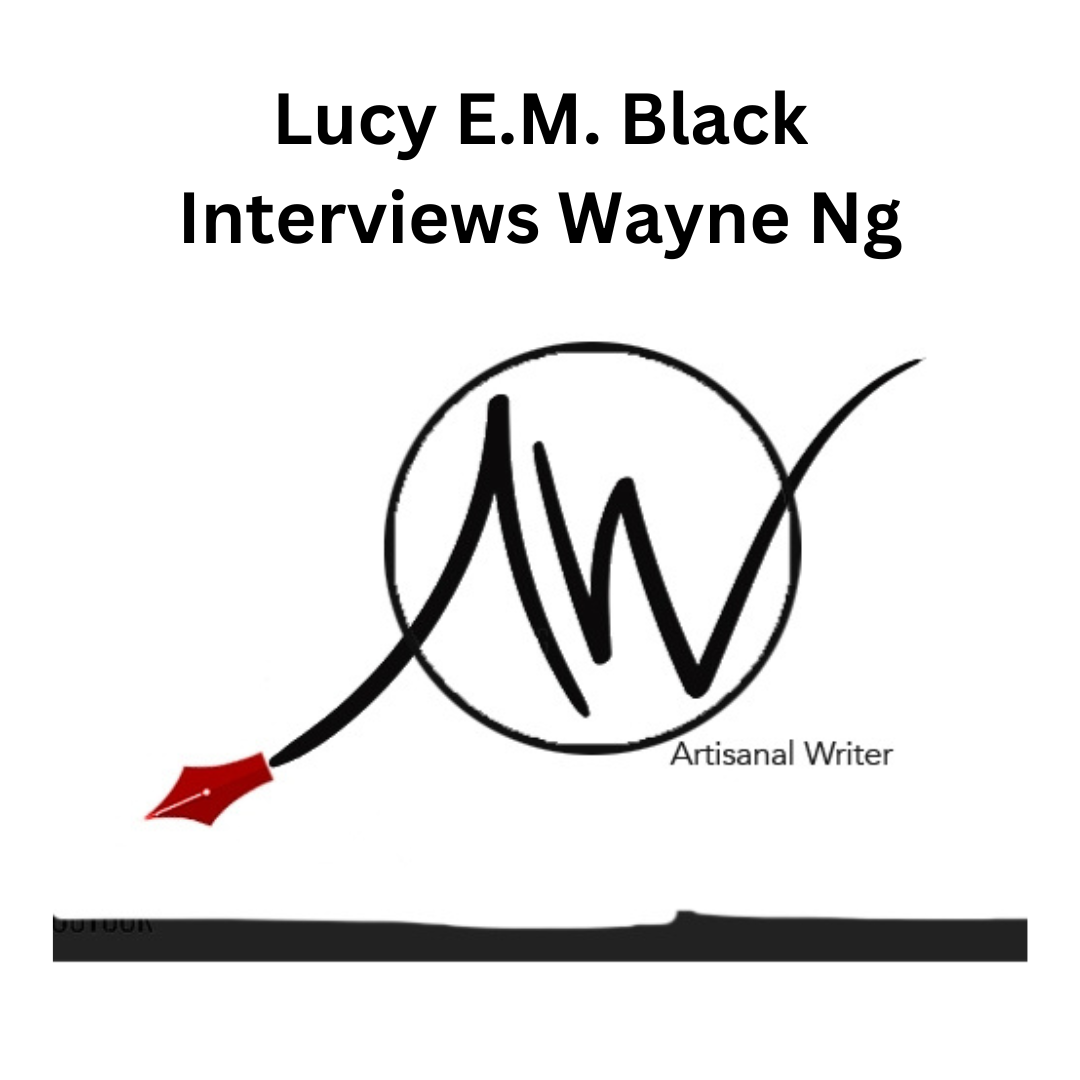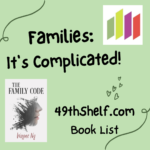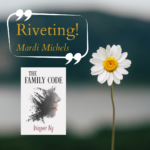Wayne had such an in-depth and thoughtful conversation with Lucy E.M. Black in The Artisanal Writer about writing his novel The Family Code.
The Artisanal Writer is an online journal about the craft of writing and reading. It explores what makes great writing, how great writing happens and how writers we love to read, make great writing happen.
Lucy E.M. Black is the author of The Marzipan Fruit Basket, Eleanor Courtown, and Stella’s Carpet. Her new novel The Brickworks was just released in October by Blue Heron Books.
Reproduced below is their conversation from The Artisanal Writer website.
————————————————
The Artisanal Writer – Ottawa writer Wayne Ng talks to Lucy Black about his latest novel.
Lucy Black (LB): Wayne, Congratulations on the publication of The Family Code. You have somehow managed to make real the world of broken and dysfunctional families without becoming pedantic or judgmental. Hannah is a deeply flawed character struggling with poverty and mental health and the long-term effects of trauma and abuse, and yet you treat her gently and with compassion. Writing such a complex character is a real achievement. Please share with us, if you will, how you were able to balance the gritty unpleasantness and cruelty in Hannah’s nature with her softer characteristics.
Wayne Ng (WN): We all have multiple dimensions in our personal lives. However, many of us will only incrementally feather them out to others or even ourselves. As incendiary as Hannah is, we all have elements of her. For example, she is forever on fight/flight/freeze mode which typically requires her to attack or defend. ‘Trust no one, assume everyone is out to hurt you, the world is a cruel place.’ It’s draining to witness, even harder to live. But if we fixate on that alone, we won’t see the many things that make Hannah all that she is. It could be something as simple as her infatuation with donairs, that she was a stellar ringette player, or that she had the same teenage insecurities as everyone else. So she has been part of something meaningful, she’s experienced joy and satisfaction. I’ve made a career of trying to connect with people who are incredibly well-defended from others and themselves. Where I’m successful, both as a social worker and a writer, is when I can tease out the minutiae of their life which allows us to connect.
LB: A cast of supportive characters attempted to interrupt the cycle of poverty and neglect in Axel’s life. They were often unsuccessful and yet, in the end, there was a great deal of hope and positivity. How did you decide how many of such people would appear in the novel, and how did you determine which of them would ultimately have lasting impact?
WN: I started with a rough outline which included the major characters and the role that they would play. However, once I got started, the scenes and characters filled themselves out. In particular, the secondary characters in Hannah’s life were improvised. Tara Lee, Jimmy, Bill, Diane, Greta, etc.… became necessary to show Hannah that she was never alone and that there were moral guideposts along the way. I wanted to replicate a village in her world. Some villagers came and went, each in their own small way, impacting Hannah and Axel. During any life, there are so many points of human contact. Some of them leave seeds that take years to germinate. Having interacted with thousands, many in education, I often run into former students and clients who reflect back to the interactions we had years ago. In the case of Bill and Tara Lee, for example, it took many years for Hannah to reconnect with them and harvest from those initial seeds.
LB: I suspect that much of this narrative was informed by your experiences as a Social Worker. Was any part of this project a response to your own ordeal as someone who witnessed from the sidelines, individuals struggling to navigate their circumstances? If so, how did this writing project assist you personally? And if not, how were you able to draw upon your experiences without becoming emotionally involved and/or depleted?
WN: You’re referring to what we call vicarious trauma or compassion fatigue. Social workers and others in the caring and helping areas are susceptible to it. However, I saw my work as a privilege more than an ordeal. Sure, there have been many times it was difficult to emotionally disconnect from my clients’ lives. Some therapists manage to remain detached and less emotionally invested. In other words, they have definite boundaries. I think they’re more likely to sleep better than me. So perhaps I didn’t always detach but I never lost my sanity.
However, good therapy is about connections and relationships. It’s hard to fake empathy and compassion without appearing mechanical. I would say my successes have often been because it was clear that my clients’ lives mattered to me and that I was invested in them getting better. I’ve been able to mine that in constructing characters and scenes without burning myself out because self-care is a real thing, an essential thing. Not only as a therapist, but as a writer. Perhaps that allowed me to stick it out for more than thirty years. THE FAMILY CODE was inspired by the many children and families, and thus I dedicated the book to them.
LB: Tell us about your decision to write this book. What inspired and/or motivated your interest in the subject matter?
WN: The Hannahs and Axels of the world turn heads and suck the oxygen out of the room. If we knew nothing about them, it would be easy to judge them as human dumpster fires, train wrecks we can’t take our eyes off. They were always the hardest and most challenging to serve, but also my favourite. They were straight up and also had the greatest potential. They are the ones who were least heard and the easiest to dismiss.
On so many occasions I was gifted with their trust and their stories. In many cases, I would be the only one to have heard them. I had been moved, inspired, curious and grateful. They gave me so much that I knew I had to give back by articulating their resilience and humour in the face of unspeakable pain. Yet I knew I had to do what every good therapist and artist does, and that is, to do the work. Which is to fearlessly dive into the dark hidden crevices of my own vulnerabilities and life to better connect with clients as a social worker and create complex characters as a writer. So, while I did it for them, the process made me a better writer, therapist and person.
LB: Share with us your driving force. What is that special energy that encourages you to be a writer?
WN: Fear and joy. Fear that the imposter in me will be outed, which makes me singularly driven to be the best writer I can be. I came by writing as a career later than most. As the son of Chinese immigrants who neither spoke nor wrote English, and were not literary, the thought of writing was never serious when I was young. However, writing now feels like a new calling and an itch that I must scratch. I feel possessed compelled to write and could not imagine my life without writing. There is also joy in writing, in the creative process, and in the community.
I’m excited about learning craft. The growth and development are wondrous. It boggles my mind how much there is to learn and the possible permutations to stories (I may sing a different tune if I hit writer’s block). It is also political. There are also things we can say and do through our writing that aren’t possible or permissible in our day jobs. Props to artists who push themselves and redefine boundaries, who take risks and allow themselves to be publicly vulnerable. While I had a rep for being outspoken as a social worker, I had taken even more risks and stirred things up even more. But it’s not too late as a writer. It feels like a second chance, a new purpose, a re-birth, a re-invention of myself.
LB: Tell us a little about your key priorities when you were working on this manuscript.
WN:
To expose the underbelly of intergenerational trauma
To highlight how silence is survival, but also perpetuates the status quo
To make people reflect on their own family systems and routines
To make the reader question how much children should bear for decisions made by others long ago
To make the reader squirm
To help people understand the daily struggles and challenges of poverty and mental health
To make the reader angry and want to throttle Hannah
To make the reader re-evaluate what empathy is
To make the reader consider their role and place in other people’s lives
To encourage readers to demand and expect complexity and layers in characters and stories
LB: If you had to choose one book that has influenced your writing life, what would that book be and how did it influence you?
WN: I recall what an incredible emotional rollercoaster it was reading Rohinton Mistry’s, A FINE BALANCE. I don’t remember much else other than how the main characters would hit rock bottom, only to sink further, then further still. It was grim and exhausting. But at the same time it was exhilarating and impossible to put down. I wanted to replicate the hypnotic, emotional complexity of that journey in THE FAMILY CODE.
If I can sneak in another: Anne-Marie McDonald’s FALL ON YOUR Knees also had a gut-wrenching wallop. Those two set the bar for emotional engagement and an experiential read. Others have reached that bar, but they were the early ones I remember and pack the same kind of impact and glow I want my work to emulate.
LB: In what way is this finished book significantly different from the first draft?
WN: Like most of my first drafts, it was unformed clay, although the intensity and rawness was already there. The significant changes were structural. It was dual POV, dual timelines, and third person. Essentially it was young Hannah and adult Hannah. The adult was so unlikeable that I felt I had to explain how that happened by showing her childhood and backstory. The early draft was pretty strong, but I knew something was missing. So, I dialed up the intensity and immediacy and put us in Hannah’s first person POV as an adult.
When Guernica Editions picked it up, they assigned one of their top gun editors, Margo Lapierre. She loved it, but then told me to blow it up and remove a third, mostly the young Hannah’s chapters and incorporate them as flashbacks.
It was hard saying goodbye to some of my favourite scenes. Nevertheless, I took that as a great way to learn and grow and revised it. I also created Axel’s present day POV, alternating chapters with his mother. This gave a counterweight to Hannah’s powerful voice and an immediacy of how her actions affected him.
LB: Was there anything edited out of this book that you wish you could have included? Why was it cut?
WN: Some readers may believe Hannah and Axel’s life was a function of poverty and single parenthood. However, intergenerational trauma, abuse, neglect, intimate partner violence, and mental health challenges run across all demographics. In fact, Hannah last lived with both her parents in a tony suburb, made possible by hard, immigrant, entrepreneurial work by her parents. Much of her early backstory was streamlined for pacing and flow.
LB: What is the most valuable piece of writing advice you have ever been given?
WN: Donald Maass’ The Emotional Craft of Writing challenges writers to inundate their work with interiority, which are the inner machinations, thoughts and feelings of our characters. I agree with his assertion that a well-crafted book balances plot and emotion, an outer journey as well as an inner journey. As a therapist, I know it is easier to talk about actions and events than it is to talk about their impact. Our feelings can go deep, but our work and our conversations are safe and shallow. I’m not talking about naming feelings, I’m talking about using techniques such as metaphors, imagery and analogies to show the deeper layers of what drives us, what shames us, what confuses us, what makes us and what we need as opposed to want. Writers who can access and wallow in their awkward, uncomfortable moments, events and feelings have so many more tools at their disposal. And if they can construct multi-dimensional characters, it really shows. How else does an Asian male write about a white female mother with trauma? I didn’t live Hannah’s life, but I could speak to her fear, her longing for safety, her sense of failure and desperation.
–
Wayne Ng was born in downtown Toronto to Chinese immigrants who fed him a steady diet of bitter melons and kung fu movies. Ng works as a school social worker in Ottawa but lives to write, travel, eat and play, preferably all at the same time. He is an award-winning author and traveler who continues to push his boundaries from the Arctic to the Antarctic. Author of THE FAMILY CODE, LETTERS FROM JOHNNY, JOHNNY DELIVERS (2024) and FINDING THE WAY: A NOVEL OF LAO TZU. Connect with Wayne at WayneNgWrites.com


